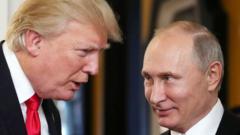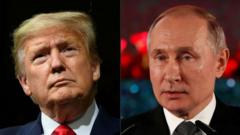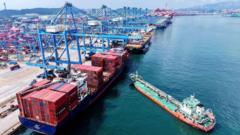As Canada approaches a pivotal election, political dynamics have shifted dramatically in recent months. Polls once indicated a conservative resurgence, but key developments, including Justin Trudeau's resignation and President Trump’s aggressive trade policies, have altered the path ahead.
How Trade Tensions and Leadership Changes Shift Canada’s Political Landscape

How Trade Tensions and Leadership Changes Shift Canada’s Political Landscape
Canada's political landscape is facing upheaval with tariffs and leadership resignations at the forefront.
Canadian voters have watched closely as the Conservative Party appeared poised to reclaim power from the long-standing Liberals. However, a wave of unexpected events has turned the tide. The resignation of Trudeau, following nearly a decade of leadership, marks a significant turning point. Coupled with President Trump's ongoing trade war, which includes punitive tariffs on vital Canadian exports like automobiles, the political landscape has become increasingly complicated.
Trump’s imposition of a 25 percent tariff on automobiles and tariffs affecting key exports has injected uncertainty into Canada’s economy. These developments coincided with Trudeau’s leadership departure, prompting many Canadians to reconsider their political affiliations. The reality of economic repercussions, specifically in the auto industry, is hitting home, leading to a reevaluation of party loyalty among constituents.
In response to Trump's trade measures, Canada has retaliated with its own tariffs on American goods, projected to yield significant revenue. Newly appointed Prime Minister Mark Carney has imposed additional tariffs as part of this defensive strategy, demonstrating a willingness to protect Canada's economic interests. His administration’s approach indicates a shift in strategy, paving the way for a potentially more aggressive stance in international trade matters.
As the April election date draws near, the Greater Toronto Area emerges as a key battleground. Major shifts in public sentiment could hinge on how voters perceive these trade issues and how they respond to the Liberal Party under new leadership.
Trump’s imposition of a 25 percent tariff on automobiles and tariffs affecting key exports has injected uncertainty into Canada’s economy. These developments coincided with Trudeau’s leadership departure, prompting many Canadians to reconsider their political affiliations. The reality of economic repercussions, specifically in the auto industry, is hitting home, leading to a reevaluation of party loyalty among constituents.
In response to Trump's trade measures, Canada has retaliated with its own tariffs on American goods, projected to yield significant revenue. Newly appointed Prime Minister Mark Carney has imposed additional tariffs as part of this defensive strategy, demonstrating a willingness to protect Canada's economic interests. His administration’s approach indicates a shift in strategy, paving the way for a potentially more aggressive stance in international trade matters.
As the April election date draws near, the Greater Toronto Area emerges as a key battleground. Major shifts in public sentiment could hinge on how voters perceive these trade issues and how they respond to the Liberal Party under new leadership.





















